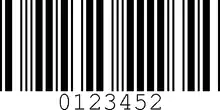
Code 11 is a barcode symbology developed by Intermec in 1977, and it is used primarily in telecommunications. The symbol can encode any length string consisting of the digits 0–9 and the dash character (-). A twelfth code represents the start/stop character, commonly printed as "*". One or two modulo-11 check digit(s) can be included.
It is a discrete, binary symbology where each digit consists of three bars and two spaces; a single narrow space separates consecutive symbols. The width of a digit is not fixed; three digits (0, 9 and -) have one wide element, while the others have two wide elements.
The valid codes have one wide bar, and may have one additional wide element (bar or space).
| Character | Widths | Barcode |
|---|---|---|
| 0 | 00001 | 101011 |
| 1 | 10001 | 1101011 |
| 2 | 01001 | 1001011 |
| 3 | 11000 | 1100101 |
| 4 | 00101 | 1011011 |
| 5 | 10100 | 1101101 |
| 6 | 01100 | 1001101 |
| 7 | 00011 | 1010011 |
| 8 | 10010 | 1101001 |
| 9 | 10000 | 110101 |
| - | 00100 | 101101 |
| Stop/Start | 00110 | 1011001 |
| Wide element | Wide bar | ||
|---|---|---|---|
| Left | Middle | Right | |
| Left bar | 9 | 5 | 1 |
| Left space | 3 | 6 | 2 |
| Middle bar | 5 | - | 4 |
| Right space | 8 | * | 7 |
| Right bar | 1 | 4 | 0 |
The decode table has 15 entries because the symbols with two wide bars (1, 4 and 5) are listed twice.
Assuming narrow elements are one unit wide and wide elements are two units, the average digit is 7.8 units. This is better than codes with a larger repertoire like Codabar (10 units) or Code 39 (11 units), but not quite as good as interleaved 2 of 5 (7 units). The non-binary symbology Code 128 uses 5.5 units per digit (11 units per digit pair).
External links
- Code 11 Symbology Specification Archived 2007-02-02 at the Wayback Machine

